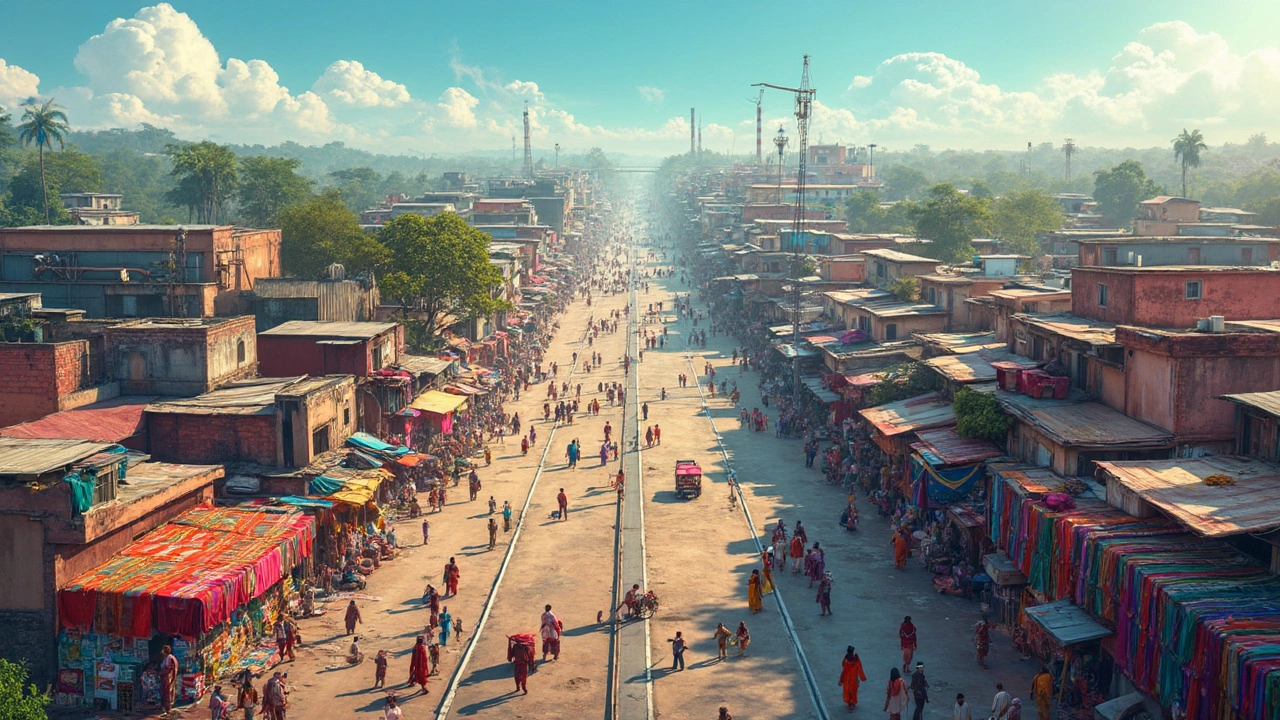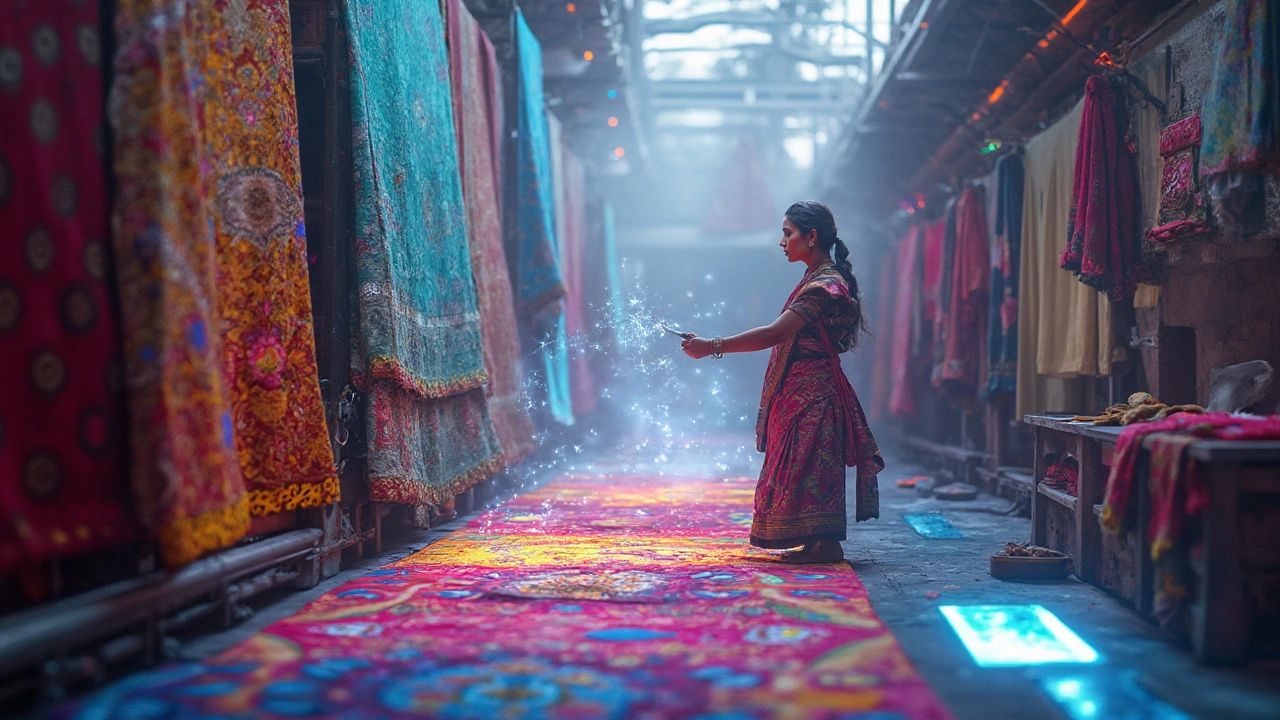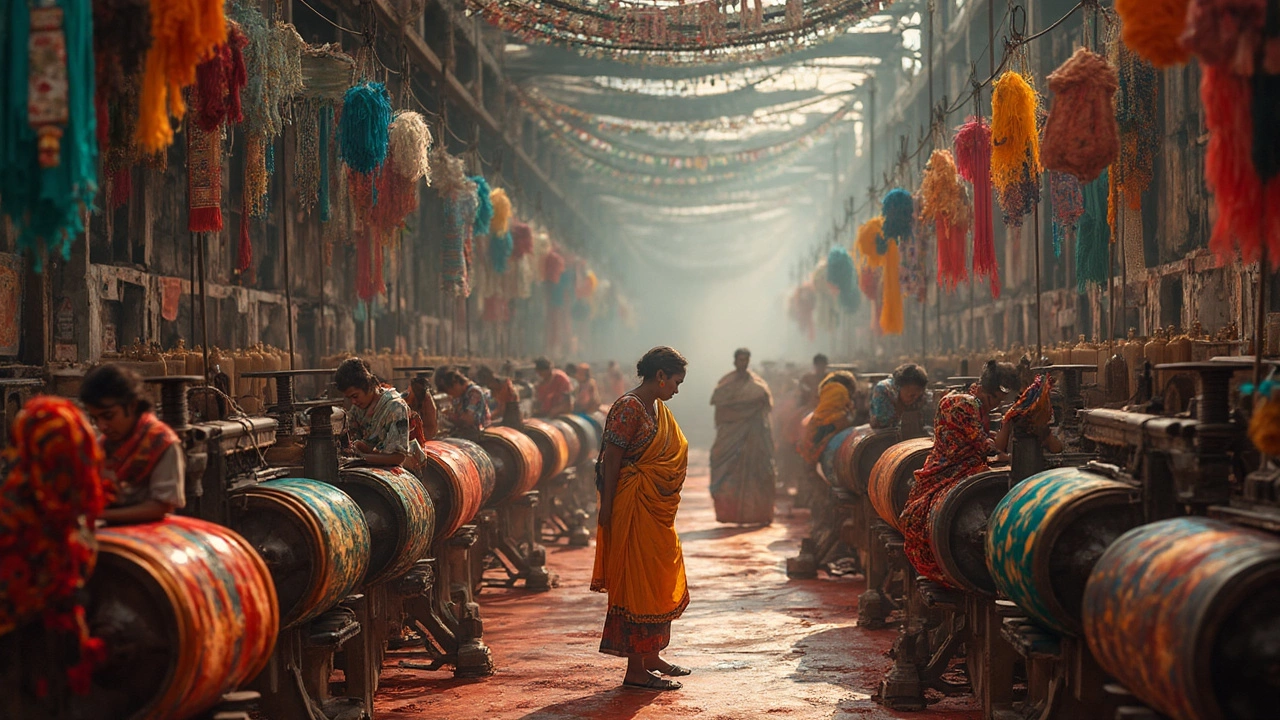India's textile industry is one of the largest in the world. But if you ever wondered just how many textile manufacturing companies dot its landscape, you're diving into an ocean of numbers and stories. Over 120,000 businesses contribute to this sector, making it a behemoth both in scale and importance.
The industry isn't just about numbers though. It's scattered into clusters, each focusing on different textile types or stages of production, from traditional saree weavers to cutting-edge fabric technology companies.
Have you heard of places like Tirupur and Surat? These aren't just towns; they're heartbeats of the garment and fabric universe. Tirupur is hailed as the country's T-shirt hub, while Surat is famed for its synthetic textiles.
- Overview of the Indian Textile Industry
- Major Hubs and Their Specialties
- Key Players and Emerging Brands
- Economic Impact of Textile Manufacturing
- Future Trends and Challenges
Overview of the Indian Textile Industry
The Indian textile industry is a giant in its own right, positioned as one of the largest industries globally. It contributes about 2.3% to India's GDP and between 12% to 14% to total exports each year. The textiles sector alone provides employment to over 45 million people directly, and 60 million people indirectly, making it the second-largest employer in the country after agriculture.
The textile scene in India is truly diverse. Ranging from the ancient art of handloom weaving to the high-tech manufacturing units producing man-made fiber, you can find everything here. This mix of tradition and technology is what makes the industry so unique and robust.
One key facet of the Indian textile industry is its segmented nature. There are major categories like cotton, silk, wool, and jute, each with a significant presence and contribution. India is the world's largest producer of cotton and jute, and ranks second in silk production. When it comes to handloom products, the country is unparalleled in terms of variety and volume.
Geographically, there's a clear layout of centers focusing on different aspects of textile manufacturing. Northern India sees a concentration in woolen textiles, while Southern India has a strong hold on cotton and mixed fabric. The Western part of the country, with cities like Surat and Mumbai, leads in textile production and exports of synthetic fabrics.
Technology and Innovation
While traditional methods hold strong, the Indian textile sector has not shied away from adopting new technologies. Companies are now leveraging automation, AI, and IoT to increase efficiency and reduce resource wastage. Many textile companies are investing in sustainability initiatives, focusing on reducing water consumption and waste.
Here's a quick look at some key stats showcasing India's role in the global textile market:
| Aspect | Global Ranking |
|---|---|
| Cotton Production | 1st |
| Jute Production | 1st |
| Silk Production | 2nd |
| Export of Garments | 5th |
Major Hubs and Their Specialties
The Indian textile industry isn't just a sprawling network. It thrives in specific regions, each with its own flair and specialty. Let's take a tour through some of the major textile hubs and see what makes them tick.
Tirupur: The T-Shirt Capital
You might not expect a small town in Tamil Nadu to be such a powerhouse, but Tirupur is internationally recognized for its textile manufacturers specializing in knitwear and T-shirts. It's a multi-billion-dollar industry here, buzzing with dyeing units, knitting factories, and printing houses. It's a perfect example of how local expertise turned a region into a global giant.
Surat: The Synthetic City
Surat in Gujarat is your go-to for everything polyester and synthetic textiles. With over 50,000 weaving structures and 700 dyeing and printing mills, it's a hub that pumps out colorful and versatile materials. Known for its lively market, Surat serves a sizeable portion of India's synthetic textile needs.
Varanasi: Traditional Weaves
Moving to the more traditional end, Varanasi is famous for its luxurious silk sarees. These aren't your everyday textiles; they're woven with intricate patterns often involving gold and silver threads. It's all about preserving craftsmanship passed down through generations.
Ludhiana: Wool and Winter Wear
Up north in Punjab, Ludhiana covers a different niche—woolen apparel. It clocks in as one of the top producers of hosiery and winter clothing, not just for India but around the world. Factories here buzz with the latest machinery to spin out everything from sweaters to socks.
Statistics and Insights
Here's a snapshot of how these hubs contribute to India's textile landscape:
| Region | Main Product | Units/Billion USD |
|---|---|---|
| Tirupur | Knitwear | 3.5 |
| Surat | Synthetic Textiles | 4 |
| Varanasi | Silk Sarees | 1.5 |
| Ludhiana | Woolen Apparel | 2 |
These regions aren't just contributing products—they're shaping the Indian textile industry's identity, catering to both traditional tastes and modern demands. Each has carved out a niche, making the industry as diverse as the country itself.

Key Players and Emerging Brands
The textile manufacturers in India don't just churn out fabric; some are iconic giants reshaping the fashion landscape globally. Let's peek into the dynamic world of India's textile bigwigs and see who's making waves.
Top Players
First up, there's Reliance Industries. They aren't just leaders in energy and retail; their Vimal brand has been a pioneer in textiles, offering path-breaking polyester innovations.
Next, think of Arvind Limited. They're the go-to name for premium denim, having partnerships with international labels like Levi's and Tommy Hilfiger. It's safe to say, when you think jeans, think Arvind.
Raymond, with its classic statement - "The Complete Man" - can't be ignored. They define luxury fabrics and pristine tailoring, having been a staple in Indian wardrobes for decades.
Emerging Brands
While these giants dominate, plenty of budding innovators are capturing attention too. Consider FabIndia. This brand uniquely amalgamates traditional Indian crafts with contemporary designs, gaining a massive following both locally and abroad.
There's also Biba, which has carved a niche catering to Indian ethnic fashion with a modern flair. With the rise of e-commerce, Biba has become a household name among Indian women.
Innovative Trends and New Entrants
Eco-aware startups are a fresh breeze in the industry. Brands like No Nasties are championing organic cotton clothing with sustainable practices, pretty much rewriting the rules on eco-conscious fashion.
And did you know? Companies like Trident Group and Welspun are harnessing tech to push textile frontiers, focusing on smart textiles and sustainability.
Here's a quick glance at their growth:
| Company | Focus Area | Innovations |
|---|---|---|
| Trident Group | Home Textiles, Paper | Sustainable Practices |
| Welspun | Home Textiles | Smart Textiles Technology |
The textile manufacturing scene in India, driven by these stalwarts and fresh faces, is evolving at a breakneck pace. As these companies grow, they're not just changing clothes; they're changing lives, providing jobs, and inspiring new generations of entrepreneurs.
Economic Impact of Textile Manufacturing
India's textile industry isn't just making clothes; it's weaving economic strength for the whole nation. This sector contributes a whopping 2% of India's GDP. That's not just fabric we're talking about, but a massive economic driver.
Let's talk jobs. With over 45 million people employed directly in textile manufacturing, it's one of the largest employer sectors in the country. Add another 60 million indirectly employed, and you can see why it's such a big deal. Textile companies in India provide more than just garments; they offer livelihoods.
Exports and Global Reach
India is the world's second-largest exporter of textiles and apparel, right behind China. Its major export markets are the United States and Europe, creating a steady flow of foreign exchange.
| Year | Textile Exports (USD Billion) |
|---|---|
| 2022 | 44 |
| 2023 | 46 |
That's just a snippet. The numbers keep climbing, showing strong global demand for Indian textiles.
Innovation and Technology
Indian textile manufacturers aren't stuck in the past. They're adopting new tech at a rapid pace, like AI in production lines or sustainable dyeing techniques. This not only boosts productivity but also helps India stay competitive on the international scene.
Challenges Ahead
Of course, it's not all smooth sailing. The industry faces challenges like fluctuating demand and raw material prices. Competition from other countries is fierce. But the resilience and adaptability of Indian textile manufacturers keep them in the game.
When you think of India, you might think of a rich cultural tapestry, but remember, it's the textile manufacturing backbone that helps weave the country's economic fabric together.

Future Trends and Challenges
The Indian textile industry is on the brink of some interesting changes. Textile manufacturers in India are facing new demands and opportunities as technology advances. With the rise of digitalization, factories are becoming smarter, using AI and IoT to improve efficiency and reduce waste. Imagine fabric making almost like on a sci-fi film, yet it's happening now.
Technological Innovations
The industry is getting a tech makeover. Startups are introducing sustainable fibers that don't just feel good but are better for the planet too. Around 60% of the production facilities are rumored to be investing in cleaner technology, reducing their carbon footprint. How cool is that?
Eco-friendly Production
Going green isn't just a trend—it's the future. Consumers are becoming more eco-conscious, and brands are under pressure to deliver. From organic cotton to dyeing processes using less water, manufacturers are stepping up. It's not just about keeping up appearances; it's about ensuring a sustainable future for everyone.
Challenges in Global Competition
Staying competitive in a global market isn't easy. China still leads as a textile giant, and newer players are emerging. Indian companies need to stay on their toes, constantly innovate, and avoid the race to the bottom in pricing, which can hurt quality and workers' livelihoods.
| Focus Area | Projected Growth |
|---|---|
| Sustainable Textiles | 20% annually |
| Smart Factories | 25% by 2028 |
| Export Markets | 10% in the next 5 years |
To wrap up, these trends and challenges represent both hurdles and chances. The ones who adapt will thrive, transforming challenges into opportunities for growth. So, if you're in the industry or just a curious soul exploring textile magic, keep an eye on these evolving dynamics.
